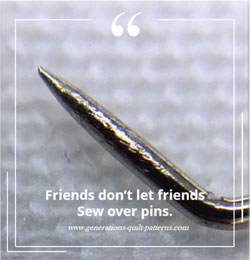- Home
- Free Motion Quilting 101
- Quilting Feathers Introduction
A ‘How To’ Guide to Quilting Feathers
An Introduction
This post contains affiliate links, for which I receive compensation.
Quilting feathers with free motion quilting is the hallmark of a good quilter.
You know it is...You've seen those quilts...drooled over them at shows.
Magnificent quilts!
All that machine quilting!
Feathers, and oodles of them!
That's what drew your attention to the quilt in the first place.
Right?...Right!!!
Now that you've been practicing your free motion quilting, feather quilting is the next step in your evolution as a machine quilter.
Let's get started!
Reality Check
I won't lie to you.
Quilting feathers is a learned skill.
There is no magic...no fairy dust.
You have to take the time to practice.
But there is good news. If you can draw a line and follow it with free motion quilting, you're more than halfway there.
If you can't, never fear. The basic skill in quilting feathers is just that...following a drawn line using free motion quilting.
No more.
No less.
Anatomy of a Feathered Design
Feathers can be marked or unmarked. They can be formal or organic. The choice is yours. Regardless of these design characteristics, the anatomy of a feather is still the same.
Learn to recognize the structure of a feathered design
You'll know where to start your quilting and how to shape feathers so that they're elegant and flowing, not stiff and distracting.
When you “fall” off the marked line as you are stitching (and EVERYONE does) you'll possess the knowledge to return gracefully to the pattern and thus avoid ripping out quilting that you're dissatisfied with.
As your knowledge grows, you'll be able to evaluate good feather designs and edit them as you need.
The Root
Feathers are quilted as they are drawn beginning at the base or “root” of the design.
To determine where the root is, imagine that the feather you are about to stitch is a real feather. Where you grasp it to tickle someone's nose is the root. The “tickling” end is the tip.
There are exceptions though. A feathered wreath based on an enclosed shape like a circle or oval doesn't have a root, but is a continuous line. The design flows with no obvious beginning or resting point. A wreath based on a pointed enclosed space like a square or rectangle has a beginning or resting place at its corners.
When you look at pictures of quilting look for the feather's' root.
Can you find it?
Is there a logical starting or stopping place?
Where would you start quilting?
The Spine
Feathers grow from a line called a spine.
Spines are either implied or stitched.
An implied spine's position is implied by the stitching of the individual feathers—it is not actually stitched. Your eye just thinks it is.
A stitched spine is exactly that. It is stitched. It can be a single line, a double line, or a filled spine.
The Barbs
Look at a bird's feather. The individual barbs (yep, that's really what they're called) on a bird's feather grow up, out and away from the spine and root. As you're quilting feathers this is exactly the motion you want to duplicate...up, out, away and merge back.
The underside of a feather is closest to the root; the upper side of a feather is closest to the tip.
If both ends of your feathered design are covered by another portion of the design, say a vase or another line of feathers, imagine running this line of feathers through your fingertips. If it would slide smoothly then you are pulling from root to tip. Pulling from tip to root would separate the individual feather strands or barbs.
Things to remember
Before you begin quilting feathers, keep the following in mind:
- Adjust your sewing machine speed until you're comfortable.If you're losing track of where you are in the design or feeling out of control, slow down. You're stitching too fast. If possible, adjust your machine to reduce the maximum speed it will stitch with the “pedal to the metal”. Practice with different speeds. I stitch unmarked free motion quilting faster than marked free motion machine quilting. Do not be intimidated by the speed at which others stitch. YOU are the one that counts!
- Clearly mark your quilt top. A solid continuously drawn line is the easiest to follow. If you are using a stencil, fill in the gaps so the line is complete. You'll appreciate the extra effort.
- Traced design lines are merely guide lines. You will stitch off the line from time to time. This is normal for everyone. But because you've marked with some sort of removable marking tool, no one will ever know once the quilting is complete and the line removed.

- Pin baste smart! Quilting the spines of your feathers is done first. If at all possible, avoid putting safety pins in a spine line while basting. It's just extra work for nothing.
- Don't sew over safety pins...EVER! It's just plain dangerous!
- Keep your eyes on where you're stitching next, not where the needle is now. This is true for all free motion quilting.
- Relax and breathe. The more you practice, the better and more confident of your quilting abilities you'll become.
Finally...
Take is easy on yourself.
Remember, nothing you do while quilting feathers can't be undone if you really don't like.
So enjoy yourself!
Quilting feathers is fun!
Next up
This is quilting! There's always more than one way to get things done. The same goes for quilting feathers.



